The time has come once more to try one other important WordPress launch: 6.5! Proper on schedule, the replace got here on the 2nd of April, 2024. We spent a little bit of time with its ultimate launch to mess around with the modifications and are excited to let you know all about them. There’s a lot to the touch upon!
There are numerous additions and enhancements on this launch, however we did our greatest to select probably the most important ones to give attention to on this publish. Nearly each facet of the WordPress CMS is getting one thing new or improved, from design additions like a font library to new block functionalities, web site editor updates that improve views, and so forth. There’s really quite a bit to speak about on this replace, so with none additional delay, allow us to start!
API Enhancements
APIs are an enormous a part of software program growth these days and for good purpose. They permit new purposes to combine with present software program programs. WordPress 6.5 brings two large enhancements on the API entrance: additional assist for the Interactivity API and the brand new Block Bindings API. These two APIs will permit WordPress to turn out to be an much more versatile platform. Firstly, the Interactivity API.
Interactivity API
The Interactivity API is, because the identify suggests, WordPress’ tackle including interactivity to your web site’s pages. Earlier than WordPress 6.5, builders needed to manually add such interactivity by means of JavaScript libraries. As you may think about, that would result in inconsistencies within the growth course of and implementation, which is a problem in itself. Nonetheless, the Interactivity API is right here to set a normal for the performance from right here on out.
With this new API, builders can add all types of interactions to the entrance finish of WordPress blocks. Issues akin to including an merchandise to your cart routinely replace the “cart” block with out you having to refresh the web page. A extra complicated instance can be dynamic pagination, which permits pages to be up to date, rendered, and generated on the fly with out having to refresh it. That may enhance the person expertise because it permits for extra seamless shopping with no interruptions. Interacting with content material with out reloading the web page is at all times significantly better for the person.
It is usually essential to notice that whereas it seems like this API would possibly decelerate web page speeds, it truly won’t. WordPress will load the scripts solely when you have interactive blocks in place and solely on the entrance finish. The API is quick and environment friendly, and it’ll not decelerate your web site.
Moreover, the API is on par with many modern-day growth instruments, assembly numerous necessities.
- Server-side rendering and client-hydrated HTML assist;
- Compatibility with present block system and PHP variations;
- Backward compatibility with WordPress hooks and JavaScript libraries;
- The API takes a declarative approach. Merely put, the code used describes what needs to be achieved as a substitute of how will probably be achieved;
- Every directive throughout the API controls a chunk of the DOM and might be mixed to create complicated purposes. In different phrases, the directives are atomic and composable;
- Lastly, it’s totally appropriate with present WordPress growth instruments, extremely performant, and totally extensible.
The interactivity API relies on directives. Directives are particular HTML attributes that may connect particular habits to DOM components. That is carried out through the use of the data-wp-interactive directive within the particular DOM aspect. The worth should be the distinctive namespace of your interactive block or plugin. An instance of such an interactive block can look one thing like this.
// render.php
$context = array('isOpen' => false);
<div
<?php echo get_block_wrapper_attributes(); ?>
<?php echo wp_interactivity_data_wp_context($context) ?>
data-wp-interactive="myPlugin"
data-wp-watch= "callbacks.logIsOpen"
>
<button
data-wp-on--click=" actions.toggle"
data-wp-bind--aria-expanded= "context.isOpen"
>
Toggle
</button>
<p id="p-1" data-wp-bind--hidden="!context.isOpen">
This aspect is now seen!
</p>
</div>Since we’re speaking about code, this modification can have probably the most important impact on present builders. It’s going to permit them to create extra interconnected and thrilling web sites. If you wish to study creating such blocks your self, you may try WordPress’ documentation on the method. Lastly, WordPress devs have put collectively a small web site to showcase the ability of the API, and you may test it out here.
Block Bindings API
The second important API addition to this replace is the Block Bindings API. Merely put, it’s going to permit block attributes to hook up with values from completely different information sources. A fast instance of it is a heading that reveals the writer, however the identify modifications relying on the post_author worth. It permits the creation of customized, dynamic fields in core blocks, also referred to as post-meta fields.
The photos, buttons, paragraphs, and headings core blocks can profit from this iteration of the Block Bindings API. The builders will add extra in future updates. The API itself works by making a binding connection between block attributes and information sources utilizing the binding object. In it, the API will search for a selected information supply to attract info from, after which it updates the block’s HTML with the brand new particulars.
Future updates will enhance the variety of blocks that may profit from this API and maybe even lengthen to customized blocks. This new API will let you draw on dynamic information from practically any supply to show in these blocks. Beforehand, WordPress didn’t have such performance, and there was no handy workaround.
Right here is an instance of a Paragraph block with an attribute sure to a customized discipline.
<!-- wp:paragraph {
"metadata" :{
"bindings" :{
"content material" :{
"supply": "core/post-meta",
"args" :{
"key": "book-genre"
}
}
}
}
} -->
<p></p>
<!-- /wp:paragraph →On this instance, the content material of the Paragraph block is sure to the info from the core/post-meta customized discipline. Moreover, it’s going to draw particularly from the book-genre customized discipline inside core/post-meta. Right here is a proof of every object and attribute from the code above.
- metadata – An object of block metadata.
- bindings – An object containing a number of bindings.
- content material – The block attribute to bind to a knowledge supply. On this instance, a Paragraph block’s content material attribute.
- supply – The bindings supply.
- args – An object of arguments to cross to the block bindings supply.
Injecting customized values into the content material of blocks was unattainable earlier than WordPress 6.5. Now, nevertheless, with the assistance of the Block Bindings API, it’s solely potential. In the intervening time, customized fields can solely be assigned to sure core blocks: buttons, headers, photos, and paragraphs. Listed below are the attributes that may be sure for every block.
- Photos – URL, alt, and title;
- Buttons – textual content, URL, linkTarget, rel;
- Paragraphs – content material;
- Headings – content material.
To start out doing that, you will need to first allow Customized Fields within the Publish editor. Go to Choices > Preferences > Normal > Superior and swap it on.
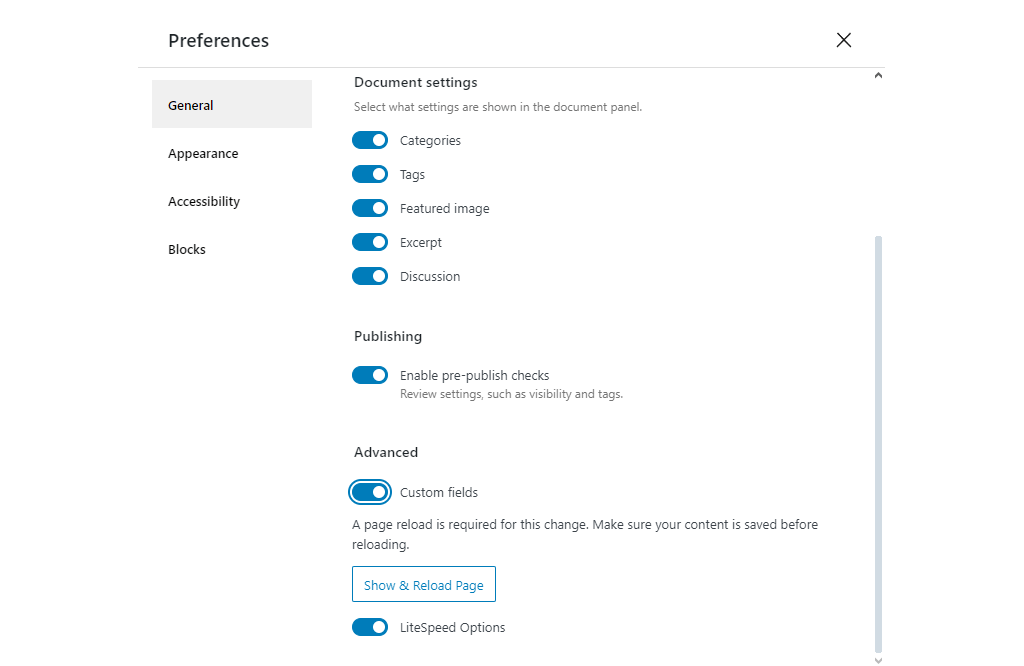
After you may have enabled it, it is possible for you to so as to add customized fields to the aforementioned blocks. Here’s what the customized fields interface appears like. It seems on the backside of the web page. We created a customized picture discipline for our instance.
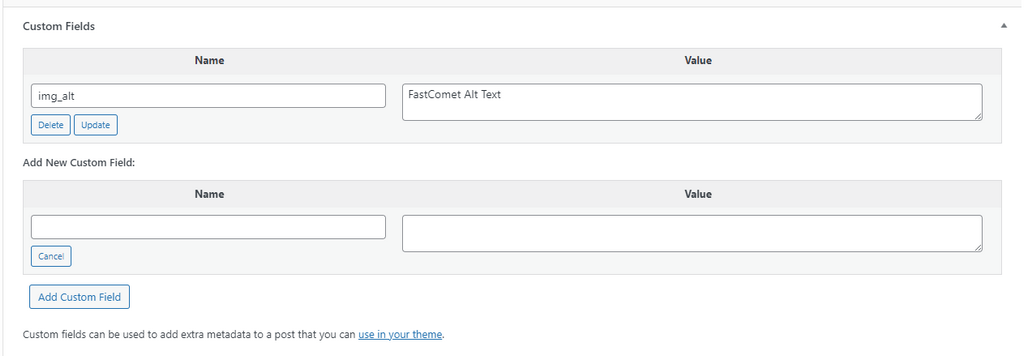
Since it is a weblog publish in regards to the modifications coming with WordPress 6.5, we advocate you try WordPress’ guide on binding customized fields to dam attributes. It’s one thing that ought to primarily have an effect on builders and supply them with extra instruments with which to work. It is best to completely attempt to construct such a block your self, although, if you happen to want some customized fields in your web site.
As you may see, although, these two API additions to WordPress will permit builders to construct extra intricate, participating, and dynamic web sites. APIs are invaluable these days, given the quantity of knowledge on the Web. Drawing upon it and displaying it immediately is such a boon.
Design Additions
Subsequent are a number of design enhancements and additions. They need to assist prevent effort and time from having to make use of customized CSS code in your web site. They embody a font library, shadows for extra blocks, and facet ratio assist for the Cowl block. Firstly, the largest change is the WordPress Font Library.
WordPress Font Library
For these of you who love to make use of completely different fonts in your web sites, this new Font Library ought to make you very glad. It’s just like how media is managed in WordPress and permits customers to simply set up and uninstall native and Google Fonts. With the Font Library, you should utilize any font in your web site, no matter your theme, with no need customized CSS.
To make use of this new function, open the location editor for any web page or publish in your web site, open the International Types sidebar, and choose Typography. You’ll then see an inventory of fonts accessible in your web site.
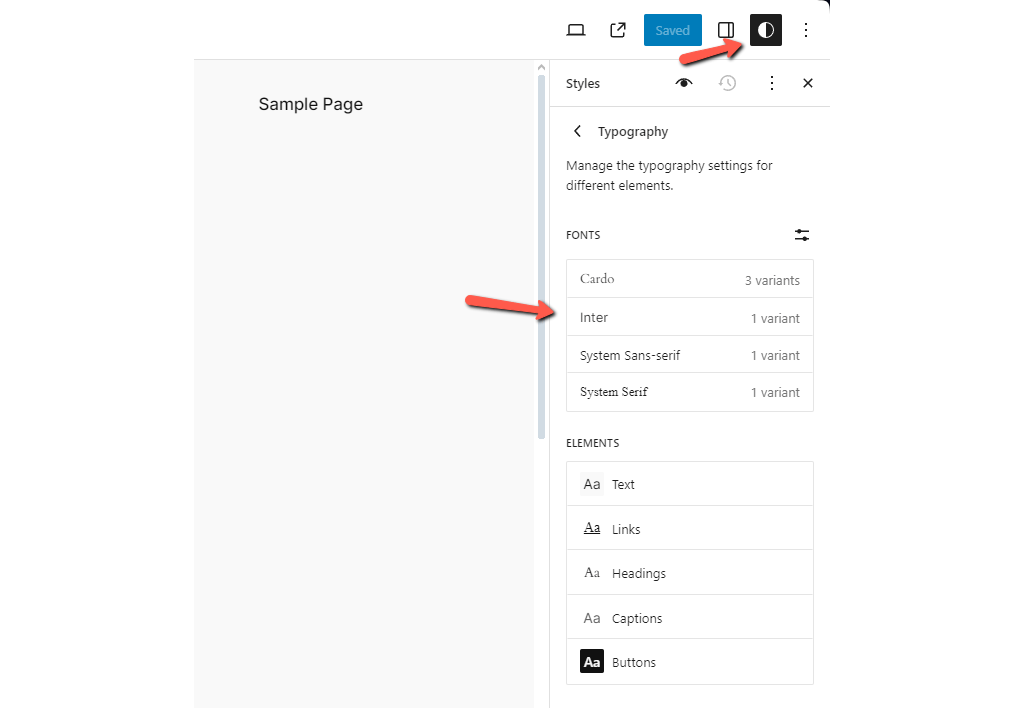
To handle your fonts, click on on the button subsequent to Fonts. This can open a pop-up with three tabs: Library, Add, and Set up Fonts.
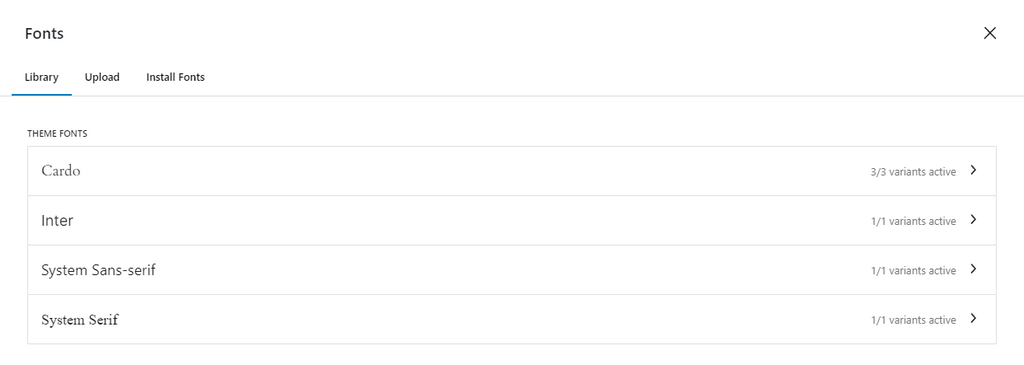
Library reveals all of the presently accessible fonts. Add permits you to drag and drop font belongings straight out of your pc. Lastly, you may set up Google Fonts from Set up Fonts. You need to give Google permission to entry your WordPress to make use of Google Fonts.
As soon as that’s carried out, you will note an inventory of all accessible fonts, or you may seek for the one you’re in search of.
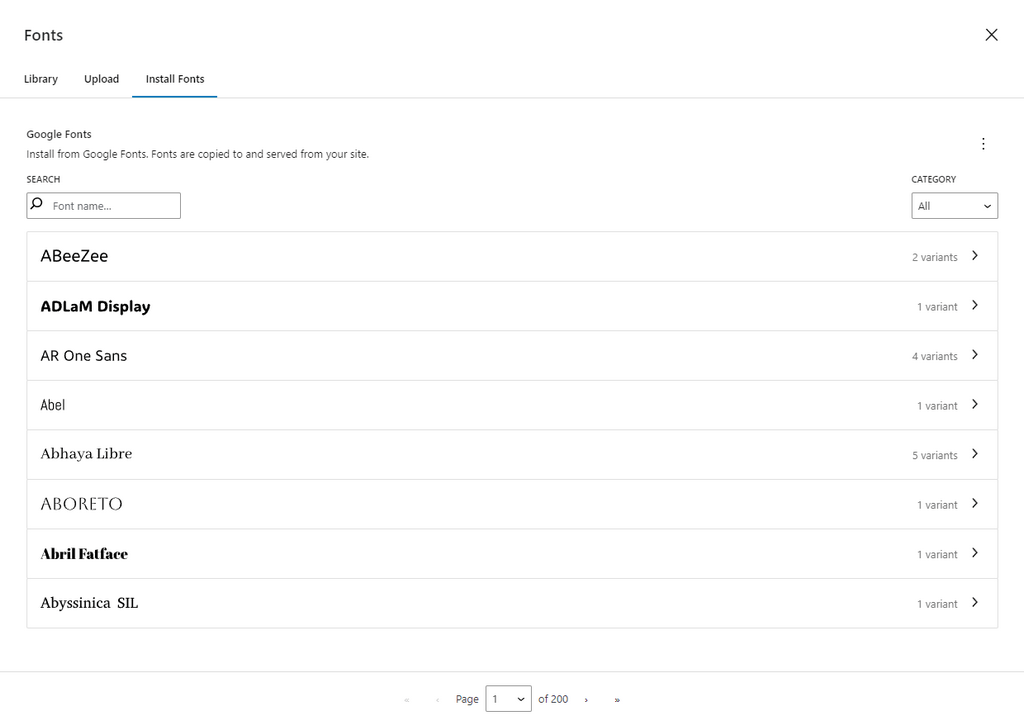
When you may have the fonts, merely click on Set up, and they are going to be added to the library. Like different media, the font information are saved within the wp-content/ listing in /fonts.
Shadow Help for Extra Blocks
Up till WordPress 6.5, solely the Button block had shadow assist. Now, the Columns, Column, and Picture blocks additionally have shadow support.
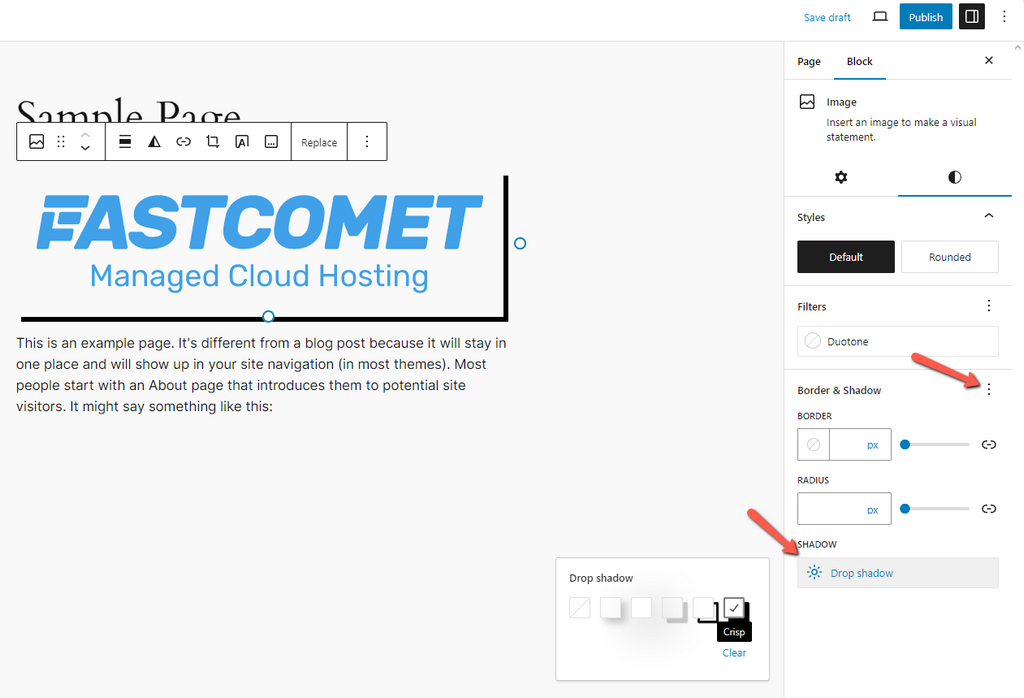
Side Ratio Help for the Cowl Block
Lastly, within the design enhancements that include WordPress 6.5, the Cowl block now has support for aspect ratio. You may have two choices right here: management the block facet ratio from the International Type interface or change it individually from the picture itself.
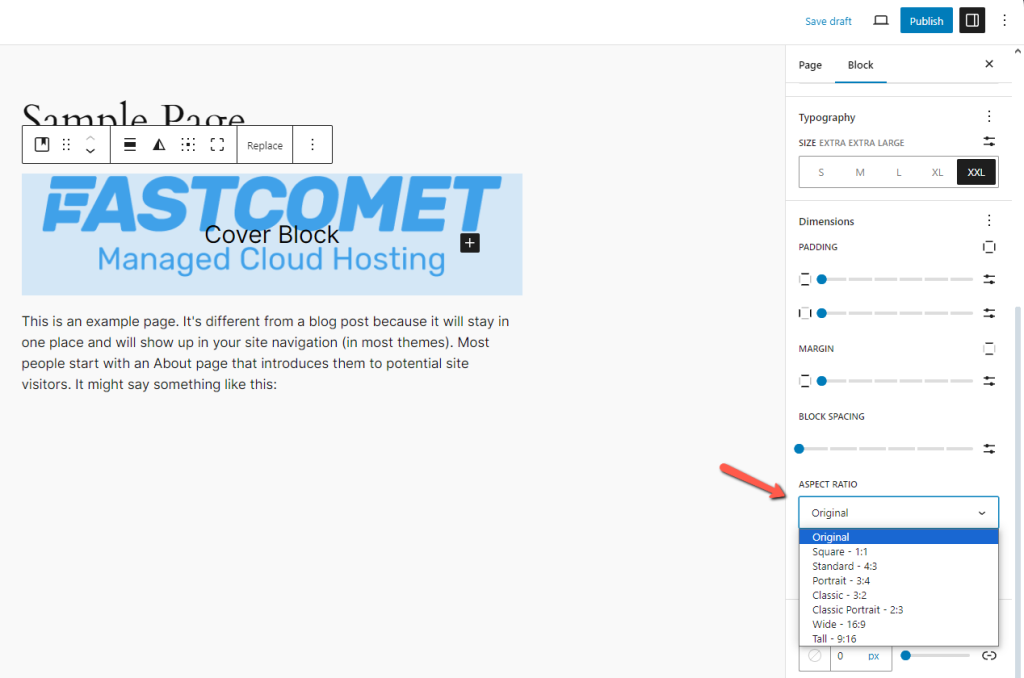
Website Editor Updates
It will not be a brand new WordPress launch with out some enhancements to the Website Editor. This time, there are three that we expect are probably the most important: the model new DataViews, enhancements to the Listing View, and the power to Duplicate and Rename Patterns. Let’s dive proper in!
DataViews
Probably the most important change to the Website Editor is the addition of DataViews. This can be a new element that enables WordPress to render datasets in several layouts: desk, grid, and so on.
On this initial iteration with WordPress 6.5, it makes use of DataViews to alter the structure of the next sections of the Website Editor.
- Templates – Listing and Grid view can be found for the Templates web page;
- Patterns – The Patterns web page itself presently helps solely the Grid structure, however the Template Elements web page has each Listing and Grid layouts;
- Pages – When managing all pages, you may organize them in both a Grid or a Listing.
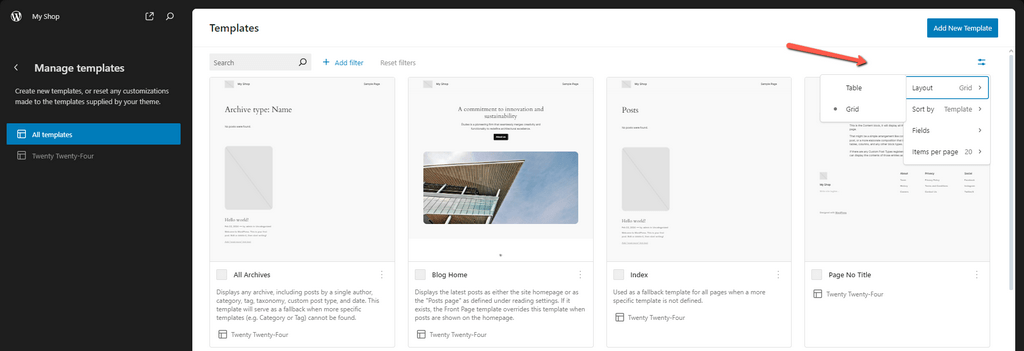
DataViews additionally provides a number of visualization options that ought to assist streamline the web page creation course of.
- Filters;
- Search;
- Pagination;
- Sorting;
- Displaying and Hiding fields.
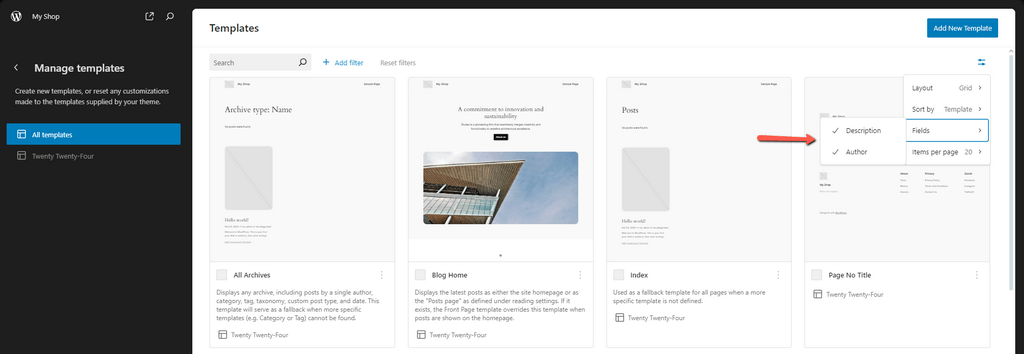
Listing View enhancements
Subsequent up are enhancements to the Listing View. Since it’s an integral a part of any WordPress workflow, we’re excited that it’s getting some love with 6.5.
First, customers can right-click on a block within the Listing View to open its settings. It’s much less important a change than the Font Library from earlier, however this one is simply so handy. Nearly anybody these days is used to right-clicking to open settings, choices, and so on. Is sensible that WordPress would add it, too!
Moreover, the Listing View itself has acquired two enhancements.
- You possibly can rename almost all blocks within the Listing View besides these ones:
- core/block;
- core/template-part;
- core/sample;
- core/navigation;
- The Listing View now additionally helps the CTRL+A (CMD+A) keyboard shortcut for choosing all of the blocks. Helpful if you wish to carry out any bulk actions.
Duplicate and Rename Patterns
Lastly, a small however essential change. The power to duplicate and rename patterns is now part of WordPress as nicely. This may not appear to be an enormous deal, but it surely truly permits customers to edit patterns supplied by themes. As issues presently are, such patterns can’t be edited to a person’s wants. With this new function that draw back might be circumvented as duplicating and renaming a sample breaks the sync settings, permitting you to edit the sample as you want.
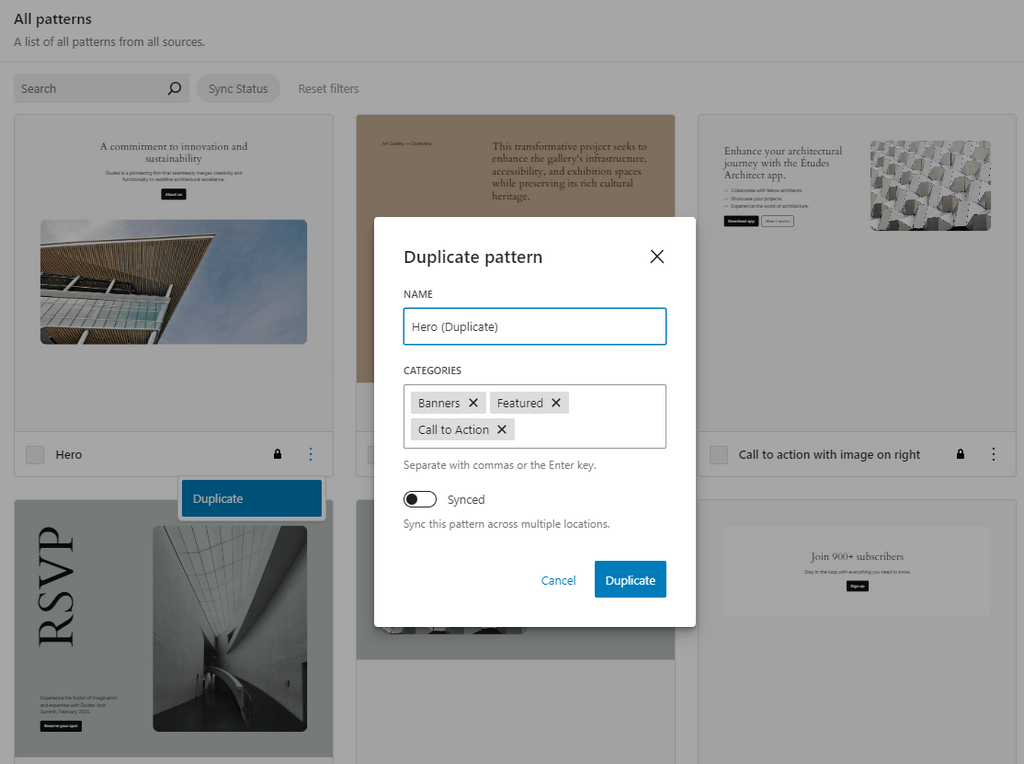
Website Administration Adjustments
The ultimate batch of essential modifications considerations managing your web site or its content material. On this part, we are going to focus on enhancements to the Type Revision System and the addition of a UI aspect for plugin dependencies.
Improved Type Revision System
With the ability to undo a change you made to your web site or publish is invaluable. That’s the reason we’re glad to let you know in regards to the improvements the Type Revision System is getting in WordPress 6.5.
First, every revision now has an outline. Beforehand, solely the date, time, and writer of a revision have been accessible. With WordPress 6.5, additionally, you will see a description of the revision.
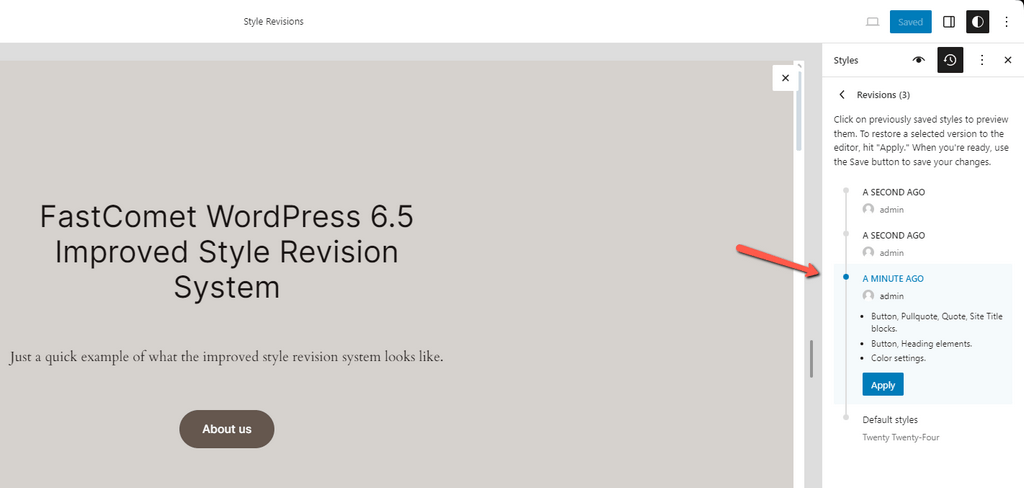
Moreover, 6.5 removes the restrict of 100 most revisions. Now, you may have limitless revisions, which you’ll browse in pages of 10. That is completed because of two new selectors: getRevision and getRevisions, launched in Gutenberg 17.2. Lastly, the revision panel is now accessible for each the Type Ebook and Templates and Template Elements.
Plugin Dependencies
WordPress 6.5 additionally introduces an excellent helpful function relating to plugin dependencies. As everyone knows, some plugins require different plugins to work. With out these “different” plugins, you’ll doubtless encounter points, or your web site will flat-out refuse to work. It may be a problem to learn by means of pages of documentation to search out what plugins you want in order that one particular plugin would work.
Happily, the brand new Requires Plugin header will permit builders to specify what plugins are required for their very own to perform.
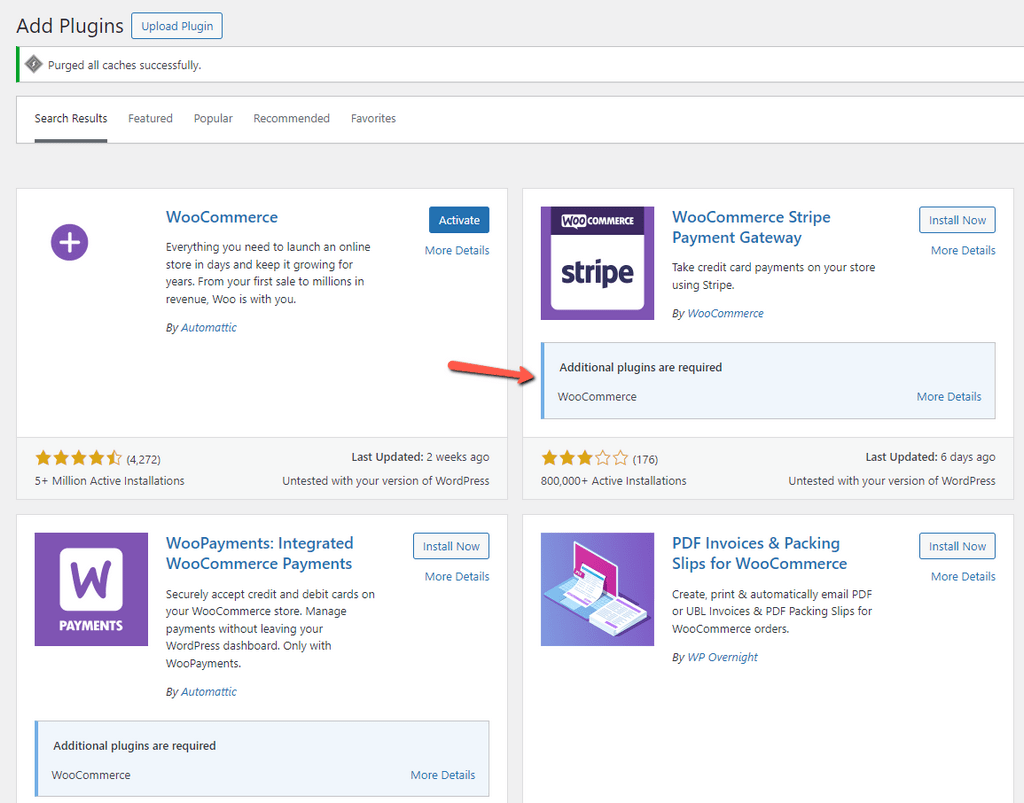
As well as, customers can see these dependencies within the Plugins part of the dashboard.
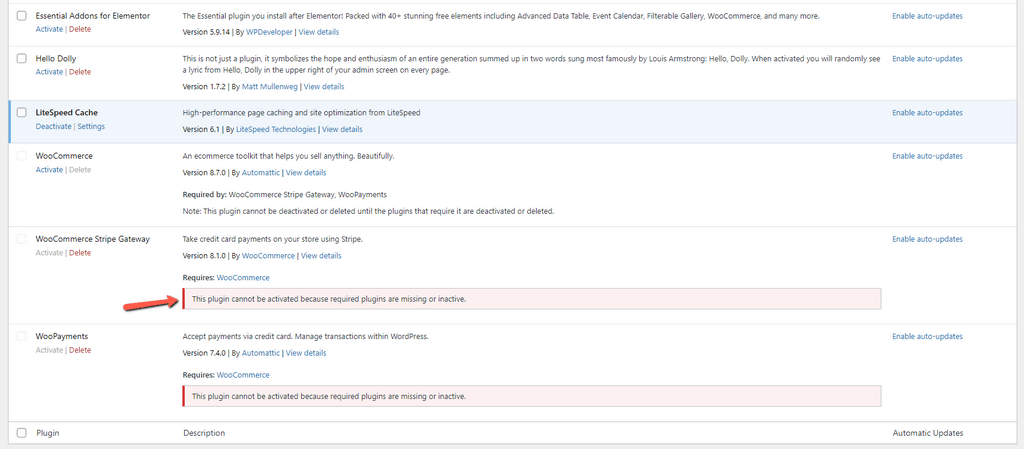
Extra Adjustments
Final, however completely not least, there are a number of extra modifications that aren’t as important as those above, so we have now bunched all of them right here with hyperlinks to their full documentation. Right here they’re!
- Traditional Themes – With 6.5 non-block themes (basic themes), will profit from a few of the options launched to the Website Editor. Since basic themes don’t use a theme.json file, if you happen to go for the appearanceTool assist, it’s going to allow the border, shade, spacing, and typography design options;
- AVIF Help – WordPress 6.5 additionally introduces support for the superior AVIF image format. It boasts higher picture high quality at the next compression ratio when in comparison with WebP. AVIF photos might be uploaded like every other from the Media Library part of the web site;
- Website and Publish Editor Unification – The newest launch goals to narrow the gap between the 2 editors and transfer one step nearer to unifying them;
- Efficiency Enhancements – Customers might be glad to listen to that WordPress 6.5 brings over 100 improvements to efficiency. Loading and enter processing occasions at the moment are no less than two occasions sooner than how they have been earlier than;
- Block Hooks – WordPress 6.4 launched Block Hooks. They have been accessible just for templates, template elements, and patterns with out person modifications. That changes with 6.5, permitting Block Hooks for use with modified templates, template elements, and patterns.
Remaining Ideas
WordPress 6.5 is critical, there aren’t any two methods about it. We don’t see this many additions and enhancements usually, however we’re at all times excited once they occur. They’re all important, too, which is probably the most important half. From the Font Library to the DataViews and all the things else in between, WordPress 6.5 brings with itself some very good modifications. Website administration, and web page enhancing and creation at the moment are extra streamlined and satisfying than ever.
We extremely advocate you replace your web site as quickly as potential. Reap the benefits of these new options and likewise maintain your web site safe. You possibly can try our WordPress tutorials on methods to replace to the 6.5 from the dashboard or through the WP Toolkit.



